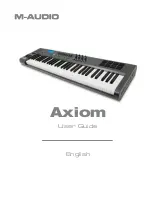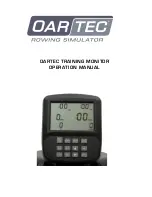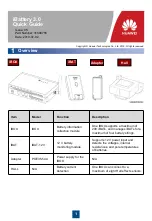
11-2
Glossary
Dialog
A page that prompts you to enter information that the K2661 needs in order to execute
an operation. Dialogs appear, for example, when you initiate a Save or Delete
operation.
Digital
A term used widely in electronics-related
fi
elds to describe a method of representing
information as a series of binary digits (bits)—1s and 0s. Digital computers process
these strings of 1s and 0s by converting them into an electrical signal that is always in
one of two very de
fi
nite states: “on” or “off.” This is much more precise than the
analog method, therefore digital computers can operate at speeds unattainable by
analog devices. Digital synthesizers like the K2661 are actually computers that process
vast strings of digital information signals, eventually converting them (at the audio
output) into the analog signals that
fl
ow into PAs and other audio systems. See also
Analog.
Digital Signal Processing
The term “Signal processing” refers to a vast range of functions, all of which have in
common the fact that they act upon an electric current as it
fl
ows through a circuit or
group of circuits. A simple form of signal processing is the distortion box used by
many guitarists.
Digital
signal processing refers to similar processes that are
performed by digital (see) circuitry as opposed to analog (see) circuitry. Many of the
effects devices available today use digital signal processing techniques.
Drum Program
Any program consisting of more than three layers. So called because in the K2000, a
special channel was required to handle programs with more than three layers—which
typically were-multi-timbral percussion programs.
Editor
The complete set of parameters used to modify a particular aspect of the K2661, for
example, the currently selected Program, which is modi
fi
ed with the Program Editor.
The Program Editor spans several display pages, which can be viewed by using the
soft buttons (the ones labeled
<more>
).
Envelope
An aperiodic modi
fi
er. In other words, a way to cause a sound to change over time
without repeating the change (unlike periodic modi
fi
ers like LFOs, which repeat at
regular intervals).
File
A group of objects stored to a
fl
oppy or hard disk, or loaded into the K2661’s RAM
from disk.
Global
In this manual, used primarily in reference to control sources. A global control source
affects all notes in a layer uniformly. If a layer uses a global control source, that control
source begins to run as soon as the program containing it is selected. Its effect on each
note will be completely in phase, regardless how many notes are being played.
Compare Local.
Hard Reset
Resets all parameter values to their defaults, and completely erases the contents of
RAM. Press the Reset button in Master mode (Mast2 page) to do a hard reset. This is a
quick way to restore the factory defaults to your K2661, but
everything
in RAM (all the
objects you’ve created) will be erased, so objects you wish to keep should be saved to
disk or SyxEx dump. A hard reset should not be used to recover if your K2661 is hung
up, except as a last resort. See Soft Reset.
KB3 Program
Uses oscillators to emulate tone wheel organs. Doesn’t use VAST processing; no
layers, keymaps, or algorithms. Requires a special channel called the KB3 channel.
Keymap
A keymap is a collection of samples assigned to speci
fi
c notes and attack velocities.
Keymaps usually contain numerous sample roots pitch-shifted across a range of
several notes. When you trigger a note, the keymap tells the K2661 what sound to
play, at what pitch, and at what loudness.
Summary of Contents for K2661
Page 18: ...2 4 LFOs LFO Shapes...
Page 34: ...3 16 DSP Algorithms...
Page 54: ...5 4 MIDI Note Numbers Note Numbers for Percussion Keymaps...
Page 72: ...7 10 System Exclusive Protocol K2661 System Exclusive Implementation...
Page 82: ...9 4 Upgrading Sample Memory Choosing and Installing a SIMM for K2661 Sample Memory...
Page 334: ...10 252 KDFX Reference KDFX Algorithm Specifications...
Page 340: ...11 6 Glossary...
Page 382: ...12 42 Triple Modular Processing Alphanumeric Buttonpad Entries for DSP Functions...
Page 392: ...B 6 SysEx Control of KDFX MSB and LSB...
Page 442: ...D 20 Contemporary ROM Block Objects Controller Assignments Contemporary ROM Block...
Page 490: ...H 12 General MIDI Standard Mode Controller Assignments...
Page 492: ...I 2 Live Mode Objects Live Mode Programs...
Page 498: ...K2661 Musician s Reference Index...
Page 500: ......
















































